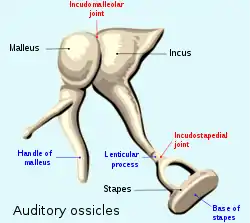Incudostapedial joint
Incudostapedial joint or articulatio incudostapedia is a small synovial joint between the incus (anvil) and the stapes (stirrup). Synovial joints are of different types depending upon the anatomy of the joint and the movement it allows. Thus, accordingly the incudostapedial joint is a ball and socket type of synovial joint. Incudomalleolar joint is gliding type of synovial joint. The joint's function is to transfer vibrations between the ossicles in the middle ear, which is perceived as sound. The ossicular systems helps in matching the impedance the sound waves suffer, hence maintaining the intensity. Contrary to other synovial joints the moment is very limited and is usually only of springy character. All of the ossicles move as a unit.
| Incudostapedial joint | |
|---|---|
 | |
 | |
| Details | |
| Identifiers | |
| Latin | Articulatio incudostapedia |
| TA98 | A15.3.02.051 |
| TA2 | 1648 |
| FMA | 60065 |
| Anatomical terminology | |
The incudostapedial joint lies between the long leg (long crus or crus longum incudis) and the head of the stapes (caput stapedis).
When the eardrum is moved inward due to sound vibrations, transferred through the outer ear, it transmits to the malleus and then to the incus via the incudomalleolar joint. The long leg (long crus or crus longum incudis) moves with the rest of the incus and a small knob, the lenticular process, articulates with the head of the stapes. The stapes then transfers the vibration to oval window.
The lenticular process of the incus participates in joint formation. It is this lenticular process of the bone which is the first to sustain assault and incur damage whenever any ear pathology develops ( acute suppurative otitis media, cholesteatoma, etc).
See also
References
- Rostgaard, Jørgen; Tranum-Jensen, Jørgen; Qvortrup, Klaus; Holm-Nielsen, Peter (2009). Hovedets, halsens & de indre organers anatomi [The Head, Neck & Internal organs anatomy] (in Danish) (10th ed.). pp. 72–73. ISBN 978-87-628-0534-7.